Roles, Responsibilities, and Relationships in Education & Training
VerifiedAdded on 2020/10/05
|33
|9515
|112
Report
AI Summary
This report delves into the multifaceted roles, responsibilities, and relationships within the realm of education and training. It begins by analyzing the author's own position as a care provider, detailing responsibilities such as training, supervision, and assessment. The report then explores relevant laws and regulations, including the Equality Act 2010 and the Health and Safety at Work Act 1974, highlighting their impact on professional conduct. The analysis extends to the relationships between teaching and other professional roles, emphasizing the importance of professional boundaries and appropriate referrals to meet learner needs. The report further examines the significance of identifying and meeting individual learner needs through initial and diagnostic assessments, the design of teaching plans, and the adaptation of resources to promote inclusivity. Various teaching and learning approaches are discussed, along with the use of communication methods and resources. Assessment methods, including peer and self-assessment, are analyzed, as well as the application of minimum core elements in inclusive teaching and learning. The report concludes with a review of the author's practice and suggestions for improvement, offering a comprehensive overview of effective educational practices.
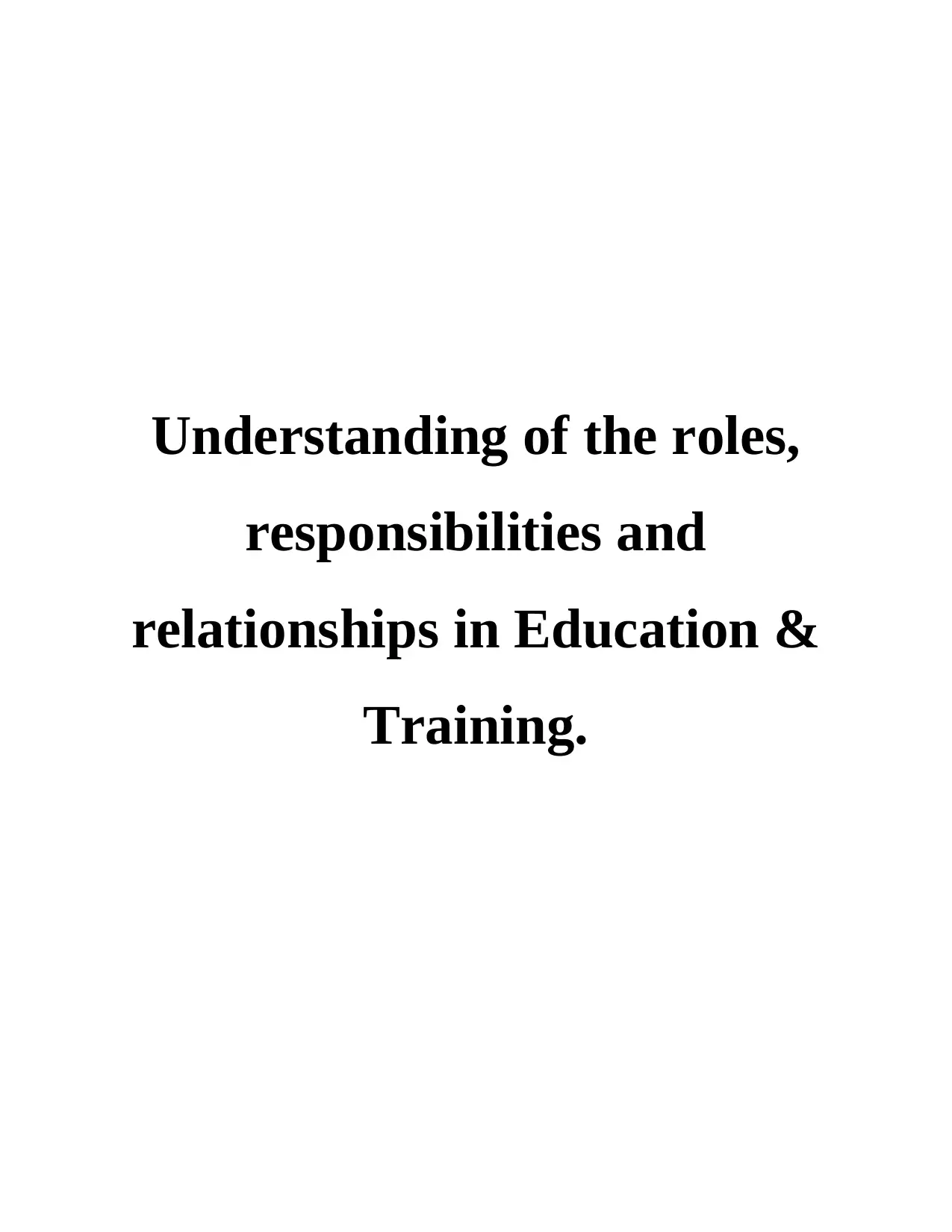
Understanding of the roles,
responsibilities and
relationships in Education &
Training.
responsibilities and
relationships in Education &
Training.
Paraphrase This Document
Need a fresh take? Get an instant paraphrase of this document with our AI Paraphraser
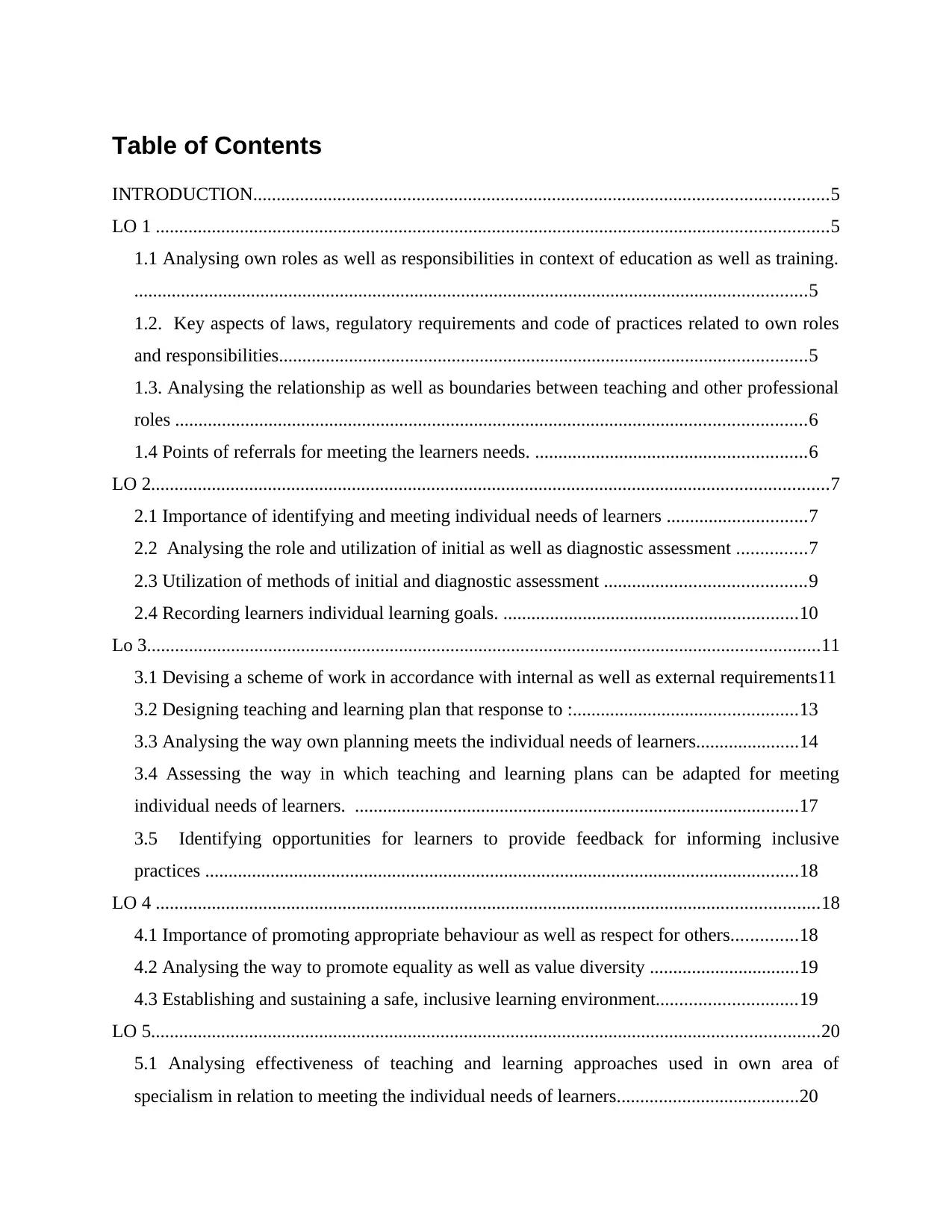
Table of Contents
INTRODUCTION...........................................................................................................................5
LO 1 ................................................................................................................................................5
1.1 Analysing own roles as well as responsibilities in context of education as well as training.
................................................................................................................................................5
1.2. Key aspects of laws, regulatory requirements and code of practices related to own roles
and responsibilities.................................................................................................................5
1.3. Analysing the relationship as well as boundaries between teaching and other professional
roles .......................................................................................................................................6
1.4 Points of referrals for meeting the learners needs. ..........................................................6
LO 2.................................................................................................................................................7
2.1 Importance of identifying and meeting individual needs of learners ..............................7
2.2 Analysing the role and utilization of initial as well as diagnostic assessment ...............7
2.3 Utilization of methods of initial and diagnostic assessment ...........................................9
2.4 Recording learners individual learning goals. ...............................................................10
Lo 3................................................................................................................................................11
3.1 Devising a scheme of work in accordance with internal as well as external requirements11
3.2 Designing teaching and learning plan that response to :................................................13
3.3 Analysing the way own planning meets the individual needs of learners......................14
3.4 Assessing the way in which teaching and learning plans can be adapted for meeting
individual needs of learners. ...............................................................................................17
3.5 Identifying opportunities for learners to provide feedback for informing inclusive
practices ...............................................................................................................................18
LO 4 ..............................................................................................................................................18
4.1 Importance of promoting appropriate behaviour as well as respect for others..............18
4.2 Analysing the way to promote equality as well as value diversity ................................19
4.3 Establishing and sustaining a safe, inclusive learning environment..............................19
LO 5...............................................................................................................................................20
5.1 Analysing effectiveness of teaching and learning approaches used in own area of
specialism in relation to meeting the individual needs of learners.......................................20
INTRODUCTION...........................................................................................................................5
LO 1 ................................................................................................................................................5
1.1 Analysing own roles as well as responsibilities in context of education as well as training.
................................................................................................................................................5
1.2. Key aspects of laws, regulatory requirements and code of practices related to own roles
and responsibilities.................................................................................................................5
1.3. Analysing the relationship as well as boundaries between teaching and other professional
roles .......................................................................................................................................6
1.4 Points of referrals for meeting the learners needs. ..........................................................6
LO 2.................................................................................................................................................7
2.1 Importance of identifying and meeting individual needs of learners ..............................7
2.2 Analysing the role and utilization of initial as well as diagnostic assessment ...............7
2.3 Utilization of methods of initial and diagnostic assessment ...........................................9
2.4 Recording learners individual learning goals. ...............................................................10
Lo 3................................................................................................................................................11
3.1 Devising a scheme of work in accordance with internal as well as external requirements11
3.2 Designing teaching and learning plan that response to :................................................13
3.3 Analysing the way own planning meets the individual needs of learners......................14
3.4 Assessing the way in which teaching and learning plans can be adapted for meeting
individual needs of learners. ...............................................................................................17
3.5 Identifying opportunities for learners to provide feedback for informing inclusive
practices ...............................................................................................................................18
LO 4 ..............................................................................................................................................18
4.1 Importance of promoting appropriate behaviour as well as respect for others..............18
4.2 Analysing the way to promote equality as well as value diversity ................................19
4.3 Establishing and sustaining a safe, inclusive learning environment..............................19
LO 5...............................................................................................................................................20
5.1 Analysing effectiveness of teaching and learning approaches used in own area of
specialism in relation to meeting the individual needs of learners.......................................20
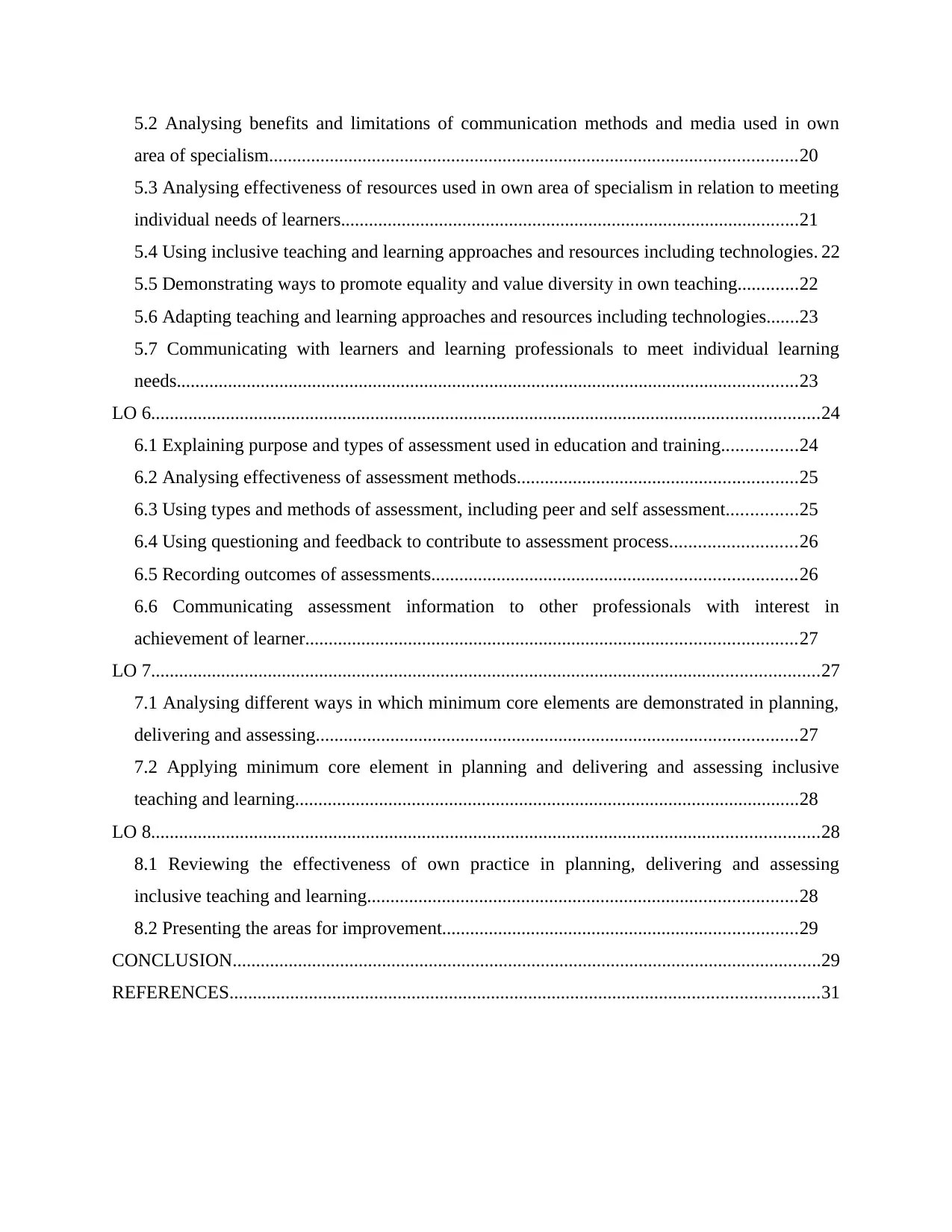
5.2 Analysing benefits and limitations of communication methods and media used in own
area of specialism.................................................................................................................20
5.3 Analysing effectiveness of resources used in own area of specialism in relation to meeting
individual needs of learners..................................................................................................21
5.4 Using inclusive teaching and learning approaches and resources including technologies. 22
5.5 Demonstrating ways to promote equality and value diversity in own teaching.............22
5.6 Adapting teaching and learning approaches and resources including technologies.......23
5.7 Communicating with learners and learning professionals to meet individual learning
needs.....................................................................................................................................23
LO 6...............................................................................................................................................24
6.1 Explaining purpose and types of assessment used in education and training................24
6.2 Analysing effectiveness of assessment methods............................................................25
6.3 Using types and methods of assessment, including peer and self assessment...............25
6.4 Using questioning and feedback to contribute to assessment process...........................26
6.5 Recording outcomes of assessments..............................................................................26
6.6 Communicating assessment information to other professionals with interest in
achievement of learner.........................................................................................................27
LO 7...............................................................................................................................................27
7.1 Analysing different ways in which minimum core elements are demonstrated in planning,
delivering and assessing.......................................................................................................27
7.2 Applying minimum core element in planning and delivering and assessing inclusive
teaching and learning............................................................................................................28
LO 8...............................................................................................................................................28
8.1 Reviewing the effectiveness of own practice in planning, delivering and assessing
inclusive teaching and learning............................................................................................28
8.2 Presenting the areas for improvement............................................................................29
CONCLUSION..............................................................................................................................29
REFERENCES..............................................................................................................................31
area of specialism.................................................................................................................20
5.3 Analysing effectiveness of resources used in own area of specialism in relation to meeting
individual needs of learners..................................................................................................21
5.4 Using inclusive teaching and learning approaches and resources including technologies. 22
5.5 Demonstrating ways to promote equality and value diversity in own teaching.............22
5.6 Adapting teaching and learning approaches and resources including technologies.......23
5.7 Communicating with learners and learning professionals to meet individual learning
needs.....................................................................................................................................23
LO 6...............................................................................................................................................24
6.1 Explaining purpose and types of assessment used in education and training................24
6.2 Analysing effectiveness of assessment methods............................................................25
6.3 Using types and methods of assessment, including peer and self assessment...............25
6.4 Using questioning and feedback to contribute to assessment process...........................26
6.5 Recording outcomes of assessments..............................................................................26
6.6 Communicating assessment information to other professionals with interest in
achievement of learner.........................................................................................................27
LO 7...............................................................................................................................................27
7.1 Analysing different ways in which minimum core elements are demonstrated in planning,
delivering and assessing.......................................................................................................27
7.2 Applying minimum core element in planning and delivering and assessing inclusive
teaching and learning............................................................................................................28
LO 8...............................................................................................................................................28
8.1 Reviewing the effectiveness of own practice in planning, delivering and assessing
inclusive teaching and learning............................................................................................28
8.2 Presenting the areas for improvement............................................................................29
CONCLUSION..............................................................................................................................29
REFERENCES..............................................................................................................................31
⊘ This is a preview!⊘
Do you want full access?
Subscribe today to unlock all pages.

Trusted by 1+ million students worldwide

Paraphrase This Document
Need a fresh take? Get an instant paraphrase of this document with our AI Paraphraser
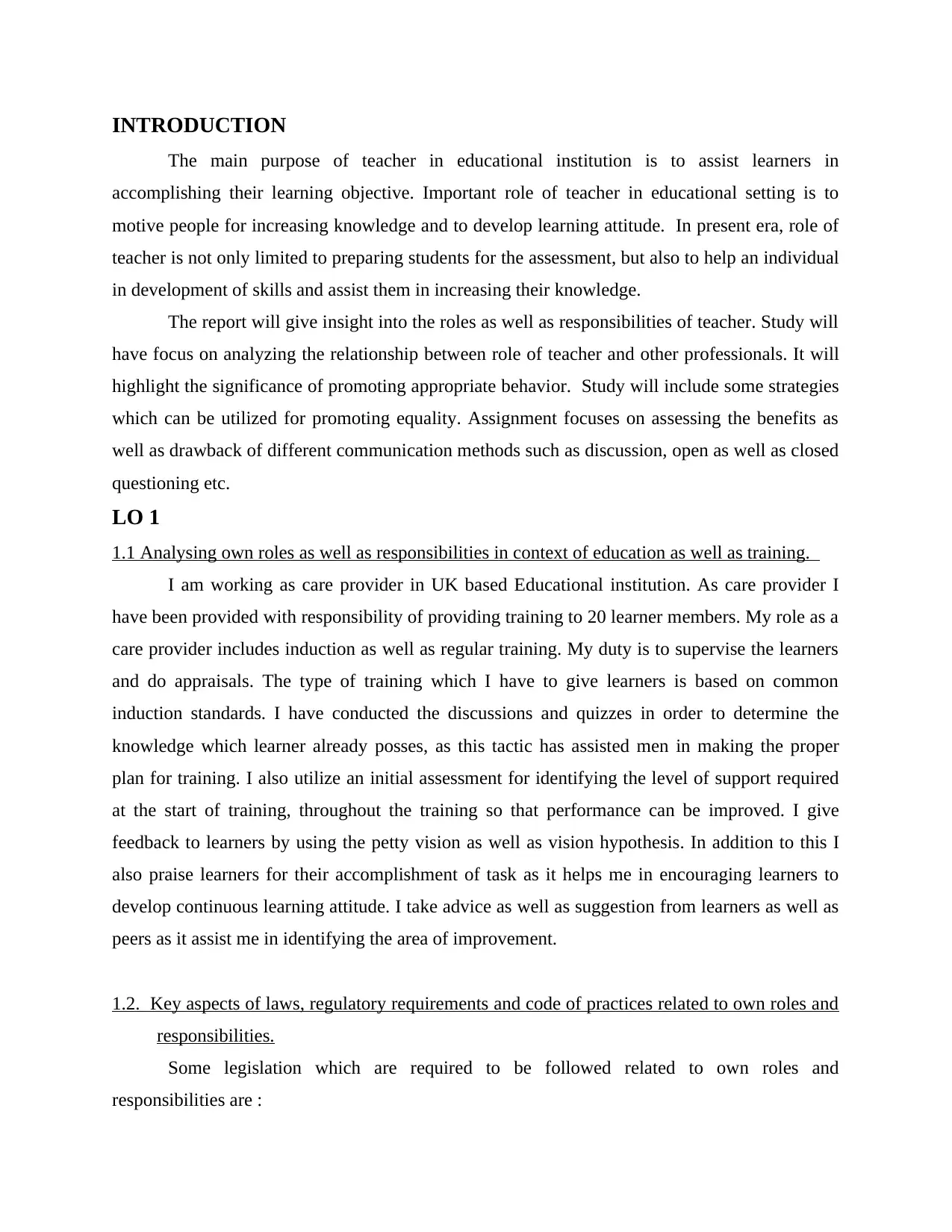
INTRODUCTION
The main purpose of teacher in educational institution is to assist learners in
accomplishing their learning objective. Important role of teacher in educational setting is to
motive people for increasing knowledge and to develop learning attitude. In present era, role of
teacher is not only limited to preparing students for the assessment, but also to help an individual
in development of skills and assist them in increasing their knowledge.
The report will give insight into the roles as well as responsibilities of teacher. Study will
have focus on analyzing the relationship between role of teacher and other professionals. It will
highlight the significance of promoting appropriate behavior. Study will include some strategies
which can be utilized for promoting equality. Assignment focuses on assessing the benefits as
well as drawback of different communication methods such as discussion, open as well as closed
questioning etc.
LO 1
1.1 Analysing own roles as well as responsibilities in context of education as well as training.
I am working as care provider in UK based Educational institution. As care provider I
have been provided with responsibility of providing training to 20 learner members. My role as a
care provider includes induction as well as regular training. My duty is to supervise the learners
and do appraisals. The type of training which I have to give learners is based on common
induction standards. I have conducted the discussions and quizzes in order to determine the
knowledge which learner already posses, as this tactic has assisted men in making the proper
plan for training. I also utilize an initial assessment for identifying the level of support required
at the start of training, throughout the training so that performance can be improved. I give
feedback to learners by using the petty vision as well as vision hypothesis. In addition to this I
also praise learners for their accomplishment of task as it helps me in encouraging learners to
develop continuous learning attitude. I take advice as well as suggestion from learners as well as
peers as it assist me in identifying the area of improvement.
1.2. Key aspects of laws, regulatory requirements and code of practices related to own roles and
responsibilities.
Some legislation which are required to be followed related to own roles and
responsibilities are :
The main purpose of teacher in educational institution is to assist learners in
accomplishing their learning objective. Important role of teacher in educational setting is to
motive people for increasing knowledge and to develop learning attitude. In present era, role of
teacher is not only limited to preparing students for the assessment, but also to help an individual
in development of skills and assist them in increasing their knowledge.
The report will give insight into the roles as well as responsibilities of teacher. Study will
have focus on analyzing the relationship between role of teacher and other professionals. It will
highlight the significance of promoting appropriate behavior. Study will include some strategies
which can be utilized for promoting equality. Assignment focuses on assessing the benefits as
well as drawback of different communication methods such as discussion, open as well as closed
questioning etc.
LO 1
1.1 Analysing own roles as well as responsibilities in context of education as well as training.
I am working as care provider in UK based Educational institution. As care provider I
have been provided with responsibility of providing training to 20 learner members. My role as a
care provider includes induction as well as regular training. My duty is to supervise the learners
and do appraisals. The type of training which I have to give learners is based on common
induction standards. I have conducted the discussions and quizzes in order to determine the
knowledge which learner already posses, as this tactic has assisted men in making the proper
plan for training. I also utilize an initial assessment for identifying the level of support required
at the start of training, throughout the training so that performance can be improved. I give
feedback to learners by using the petty vision as well as vision hypothesis. In addition to this I
also praise learners for their accomplishment of task as it helps me in encouraging learners to
develop continuous learning attitude. I take advice as well as suggestion from learners as well as
peers as it assist me in identifying the area of improvement.
1.2. Key aspects of laws, regulatory requirements and code of practices related to own roles and
responsibilities.
Some legislation which are required to be followed related to own roles and
responsibilities are :
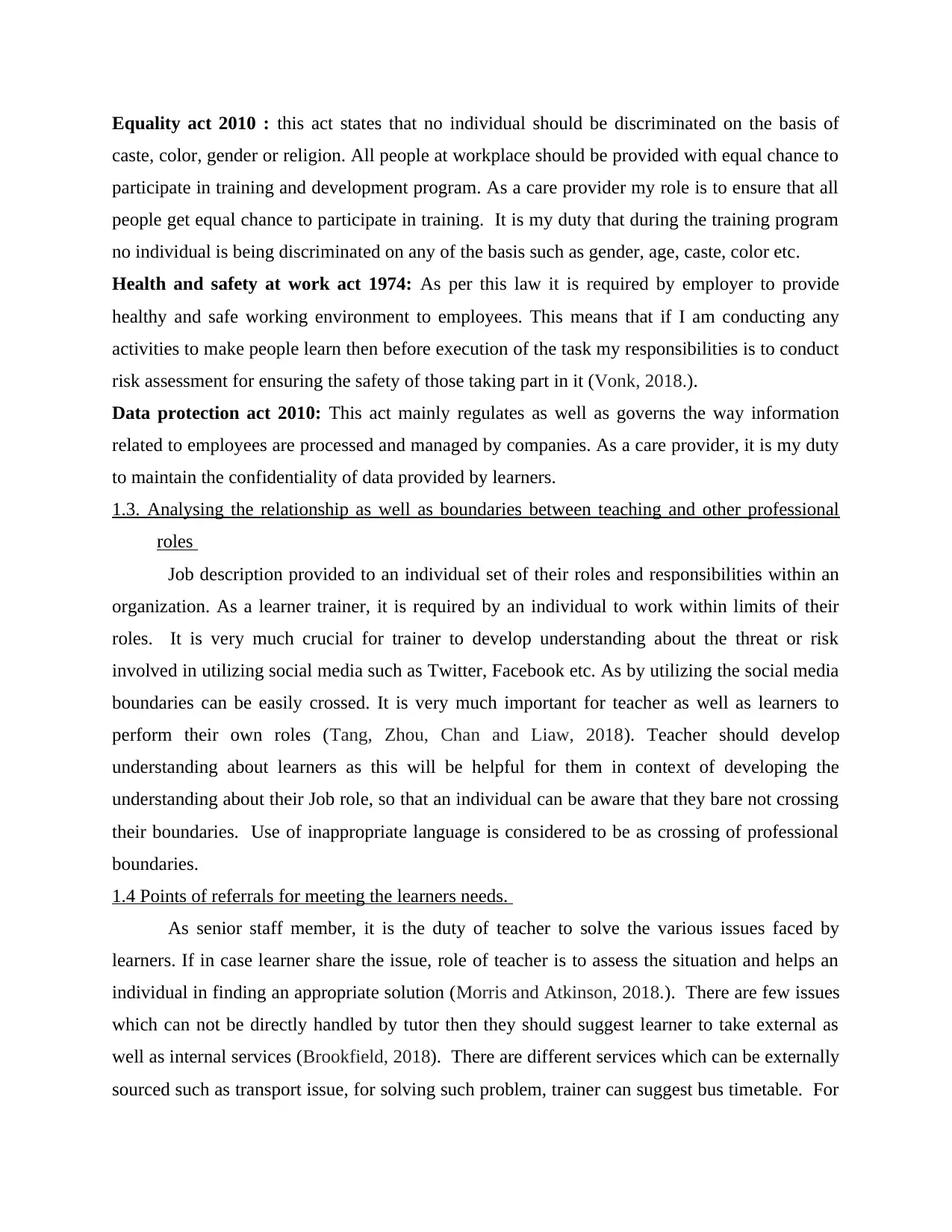
Equality act 2010 : this act states that no individual should be discriminated on the basis of
caste, color, gender or religion. All people at workplace should be provided with equal chance to
participate in training and development program. As a care provider my role is to ensure that all
people get equal chance to participate in training. It is my duty that during the training program
no individual is being discriminated on any of the basis such as gender, age, caste, color etc.
Health and safety at work act 1974: As per this law it is required by employer to provide
healthy and safe working environment to employees. This means that if I am conducting any
activities to make people learn then before execution of the task my responsibilities is to conduct
risk assessment for ensuring the safety of those taking part in it (Vonk, 2018.).
Data protection act 2010: This act mainly regulates as well as governs the way information
related to employees are processed and managed by companies. As a care provider, it is my duty
to maintain the confidentiality of data provided by learners.
1.3. Analysing the relationship as well as boundaries between teaching and other professional
roles
Job description provided to an individual set of their roles and responsibilities within an
organization. As a learner trainer, it is required by an individual to work within limits of their
roles. It is very much crucial for trainer to develop understanding about the threat or risk
involved in utilizing social media such as Twitter, Facebook etc. As by utilizing the social media
boundaries can be easily crossed. It is very much important for teacher as well as learners to
perform their own roles (Tang, Zhou, Chan and Liaw, 2018). Teacher should develop
understanding about learners as this will be helpful for them in context of developing the
understanding about their Job role, so that an individual can be aware that they bare not crossing
their boundaries. Use of inappropriate language is considered to be as crossing of professional
boundaries.
1.4 Points of referrals for meeting the learners needs.
As senior staff member, it is the duty of teacher to solve the various issues faced by
learners. If in case learner share the issue, role of teacher is to assess the situation and helps an
individual in finding an appropriate solution (Morris and Atkinson, 2018.). There are few issues
which can not be directly handled by tutor then they should suggest learner to take external as
well as internal services (Brookfield, 2018). There are different services which can be externally
sourced such as transport issue, for solving such problem, trainer can suggest bus timetable. For
caste, color, gender or religion. All people at workplace should be provided with equal chance to
participate in training and development program. As a care provider my role is to ensure that all
people get equal chance to participate in training. It is my duty that during the training program
no individual is being discriminated on any of the basis such as gender, age, caste, color etc.
Health and safety at work act 1974: As per this law it is required by employer to provide
healthy and safe working environment to employees. This means that if I am conducting any
activities to make people learn then before execution of the task my responsibilities is to conduct
risk assessment for ensuring the safety of those taking part in it (Vonk, 2018.).
Data protection act 2010: This act mainly regulates as well as governs the way information
related to employees are processed and managed by companies. As a care provider, it is my duty
to maintain the confidentiality of data provided by learners.
1.3. Analysing the relationship as well as boundaries between teaching and other professional
roles
Job description provided to an individual set of their roles and responsibilities within an
organization. As a learner trainer, it is required by an individual to work within limits of their
roles. It is very much crucial for trainer to develop understanding about the threat or risk
involved in utilizing social media such as Twitter, Facebook etc. As by utilizing the social media
boundaries can be easily crossed. It is very much important for teacher as well as learners to
perform their own roles (Tang, Zhou, Chan and Liaw, 2018). Teacher should develop
understanding about learners as this will be helpful for them in context of developing the
understanding about their Job role, so that an individual can be aware that they bare not crossing
their boundaries. Use of inappropriate language is considered to be as crossing of professional
boundaries.
1.4 Points of referrals for meeting the learners needs.
As senior staff member, it is the duty of teacher to solve the various issues faced by
learners. If in case learner share the issue, role of teacher is to assess the situation and helps an
individual in finding an appropriate solution (Morris and Atkinson, 2018.). There are few issues
which can not be directly handled by tutor then they should suggest learner to take external as
well as internal services (Brookfield, 2018). There are different services which can be externally
sourced such as transport issue, for solving such problem, trainer can suggest bus timetable. For
⊘ This is a preview!⊘
Do you want full access?
Subscribe today to unlock all pages.

Trusted by 1+ million students worldwide
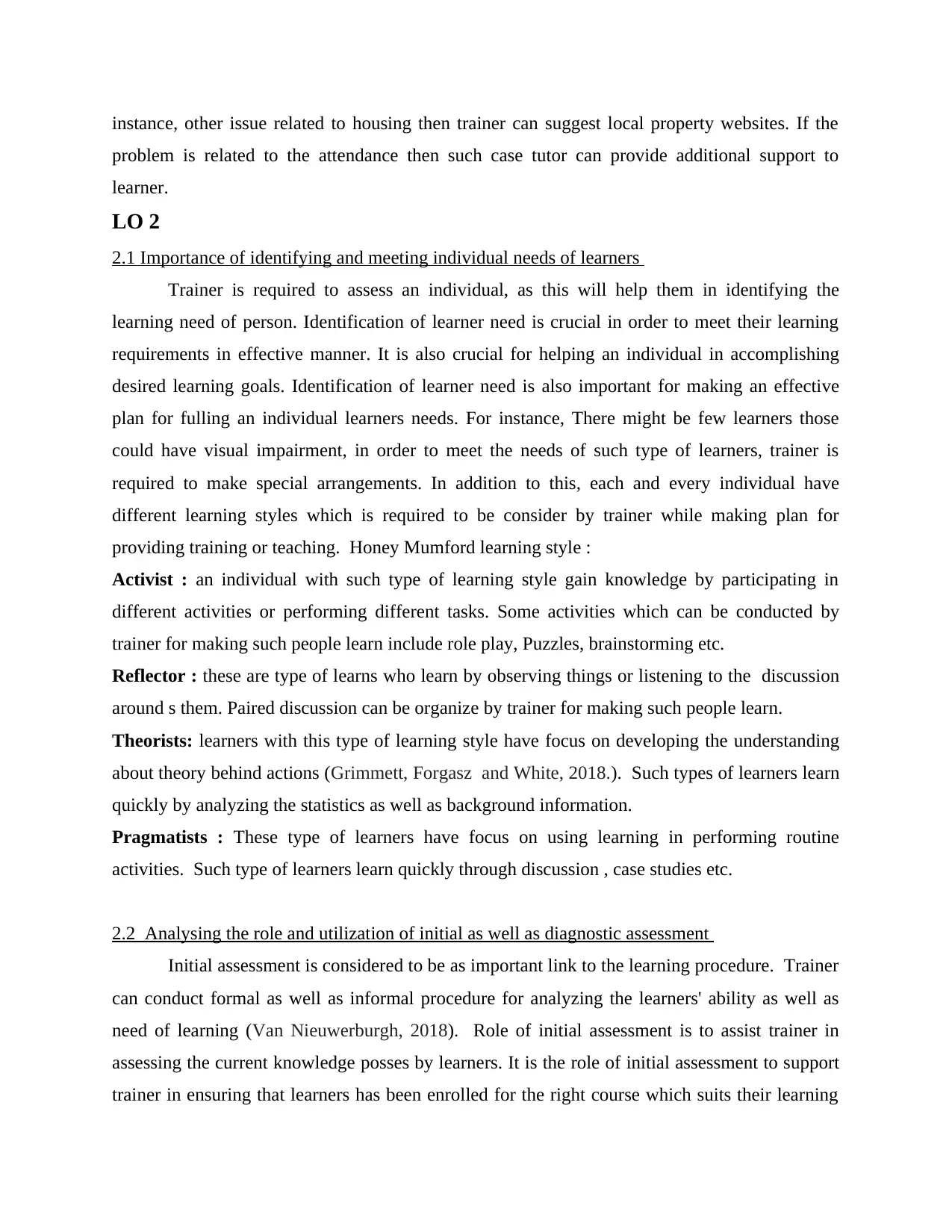
instance, other issue related to housing then trainer can suggest local property websites. If the
problem is related to the attendance then such case tutor can provide additional support to
learner.
LO 2
2.1 Importance of identifying and meeting individual needs of learners
Trainer is required to assess an individual, as this will help them in identifying the
learning need of person. Identification of learner need is crucial in order to meet their learning
requirements in effective manner. It is also crucial for helping an individual in accomplishing
desired learning goals. Identification of learner need is also important for making an effective
plan for fulling an individual learners needs. For instance, There might be few learners those
could have visual impairment, in order to meet the needs of such type of learners, trainer is
required to make special arrangements. In addition to this, each and every individual have
different learning styles which is required to be consider by trainer while making plan for
providing training or teaching. Honey Mumford learning style :
Activist : an individual with such type of learning style gain knowledge by participating in
different activities or performing different tasks. Some activities which can be conducted by
trainer for making such people learn include role play, Puzzles, brainstorming etc.
Reflector : these are type of learns who learn by observing things or listening to the discussion
around s them. Paired discussion can be organize by trainer for making such people learn.
Theorists: learners with this type of learning style have focus on developing the understanding
about theory behind actions (Grimmett, Forgasz and White, 2018.). Such types of learners learn
quickly by analyzing the statistics as well as background information.
Pragmatists : These type of learners have focus on using learning in performing routine
activities. Such type of learners learn quickly through discussion , case studies etc.
2.2 Analysing the role and utilization of initial as well as diagnostic assessment
Initial assessment is considered to be as important link to the learning procedure. Trainer
can conduct formal as well as informal procedure for analyzing the learners' ability as well as
need of learning (Van Nieuwerburgh, 2018). Role of initial assessment is to assist trainer in
assessing the current knowledge posses by learners. It is the role of initial assessment to support
trainer in ensuring that learners has been enrolled for the right course which suits their learning
problem is related to the attendance then such case tutor can provide additional support to
learner.
LO 2
2.1 Importance of identifying and meeting individual needs of learners
Trainer is required to assess an individual, as this will help them in identifying the
learning need of person. Identification of learner need is crucial in order to meet their learning
requirements in effective manner. It is also crucial for helping an individual in accomplishing
desired learning goals. Identification of learner need is also important for making an effective
plan for fulling an individual learners needs. For instance, There might be few learners those
could have visual impairment, in order to meet the needs of such type of learners, trainer is
required to make special arrangements. In addition to this, each and every individual have
different learning styles which is required to be consider by trainer while making plan for
providing training or teaching. Honey Mumford learning style :
Activist : an individual with such type of learning style gain knowledge by participating in
different activities or performing different tasks. Some activities which can be conducted by
trainer for making such people learn include role play, Puzzles, brainstorming etc.
Reflector : these are type of learns who learn by observing things or listening to the discussion
around s them. Paired discussion can be organize by trainer for making such people learn.
Theorists: learners with this type of learning style have focus on developing the understanding
about theory behind actions (Grimmett, Forgasz and White, 2018.). Such types of learners learn
quickly by analyzing the statistics as well as background information.
Pragmatists : These type of learners have focus on using learning in performing routine
activities. Such type of learners learn quickly through discussion , case studies etc.
2.2 Analysing the role and utilization of initial as well as diagnostic assessment
Initial assessment is considered to be as important link to the learning procedure. Trainer
can conduct formal as well as informal procedure for analyzing the learners' ability as well as
need of learning (Van Nieuwerburgh, 2018). Role of initial assessment is to assist trainer in
assessing the current knowledge posses by learners. It is the role of initial assessment to support
trainer in ensuring that learners has been enrolled for the right course which suits their learning
Paraphrase This Document
Need a fresh take? Get an instant paraphrase of this document with our AI Paraphraser
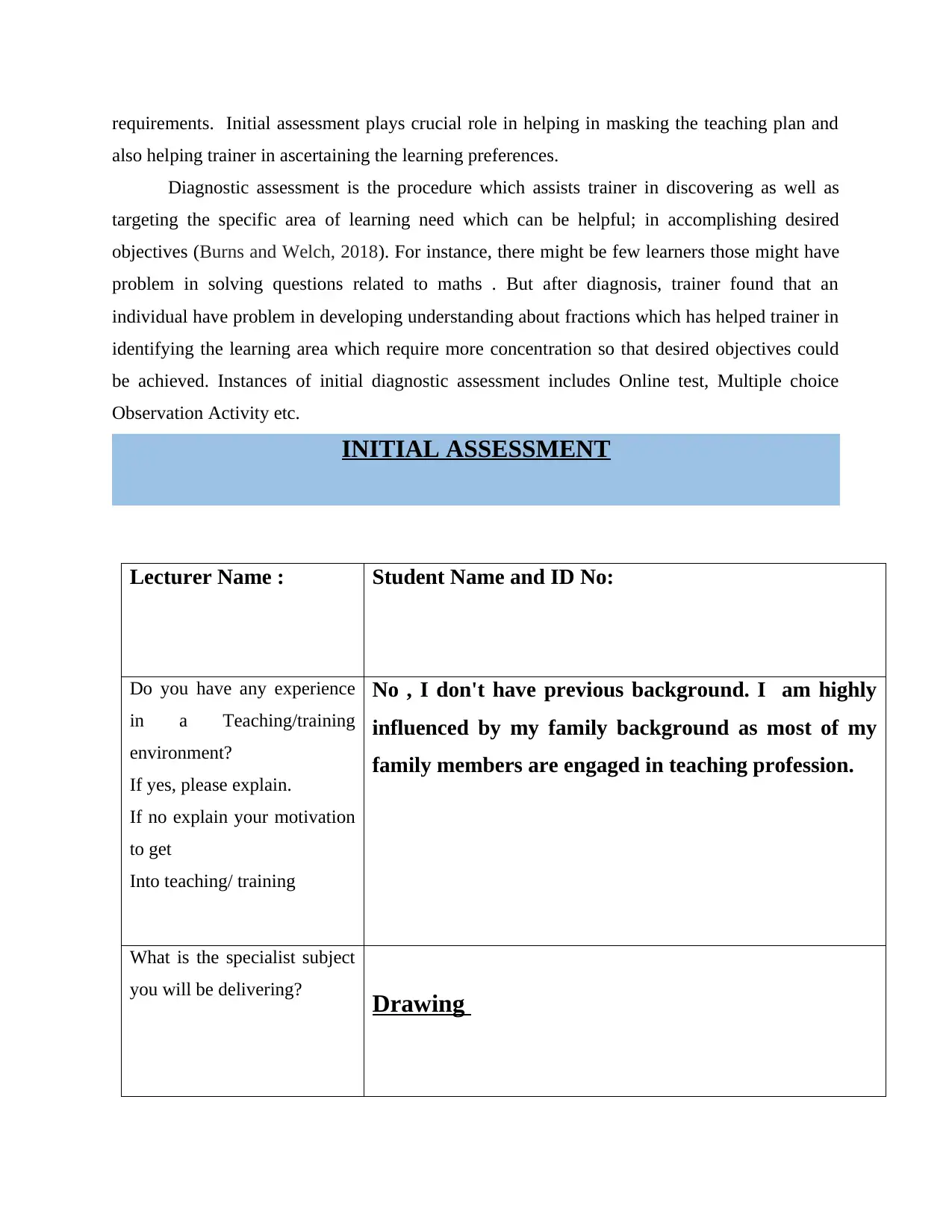
requirements. Initial assessment plays crucial role in helping in masking the teaching plan and
also helping trainer in ascertaining the learning preferences.
Diagnostic assessment is the procedure which assists trainer in discovering as well as
targeting the specific area of learning need which can be helpful; in accomplishing desired
objectives (Burns and Welch, 2018). For instance, there might be few learners those might have
problem in solving questions related to maths . But after diagnosis, trainer found that an
individual have problem in developing understanding about fractions which has helped trainer in
identifying the learning area which require more concentration so that desired objectives could
be achieved. Instances of initial diagnostic assessment includes Online test, Multiple choice
Observation Activity etc.
INITIAL ASSESSMENT
Lecturer Name : Student Name and ID No:
Do you have any experience
in a Teaching/training
environment?
If yes, please explain.
If no explain your motivation
to get
Into teaching/ training
No , I don't have previous background. I am highly
influenced by my family background as most of my
family members are engaged in teaching profession.
What is the specialist subject
you will be delivering? Drawing
also helping trainer in ascertaining the learning preferences.
Diagnostic assessment is the procedure which assists trainer in discovering as well as
targeting the specific area of learning need which can be helpful; in accomplishing desired
objectives (Burns and Welch, 2018). For instance, there might be few learners those might have
problem in solving questions related to maths . But after diagnosis, trainer found that an
individual have problem in developing understanding about fractions which has helped trainer in
identifying the learning area which require more concentration so that desired objectives could
be achieved. Instances of initial diagnostic assessment includes Online test, Multiple choice
Observation Activity etc.
INITIAL ASSESSMENT
Lecturer Name : Student Name and ID No:
Do you have any experience
in a Teaching/training
environment?
If yes, please explain.
If no explain your motivation
to get
Into teaching/ training
No , I don't have previous background. I am highly
influenced by my family background as most of my
family members are engaged in teaching profession.
What is the specialist subject
you will be delivering? Drawing
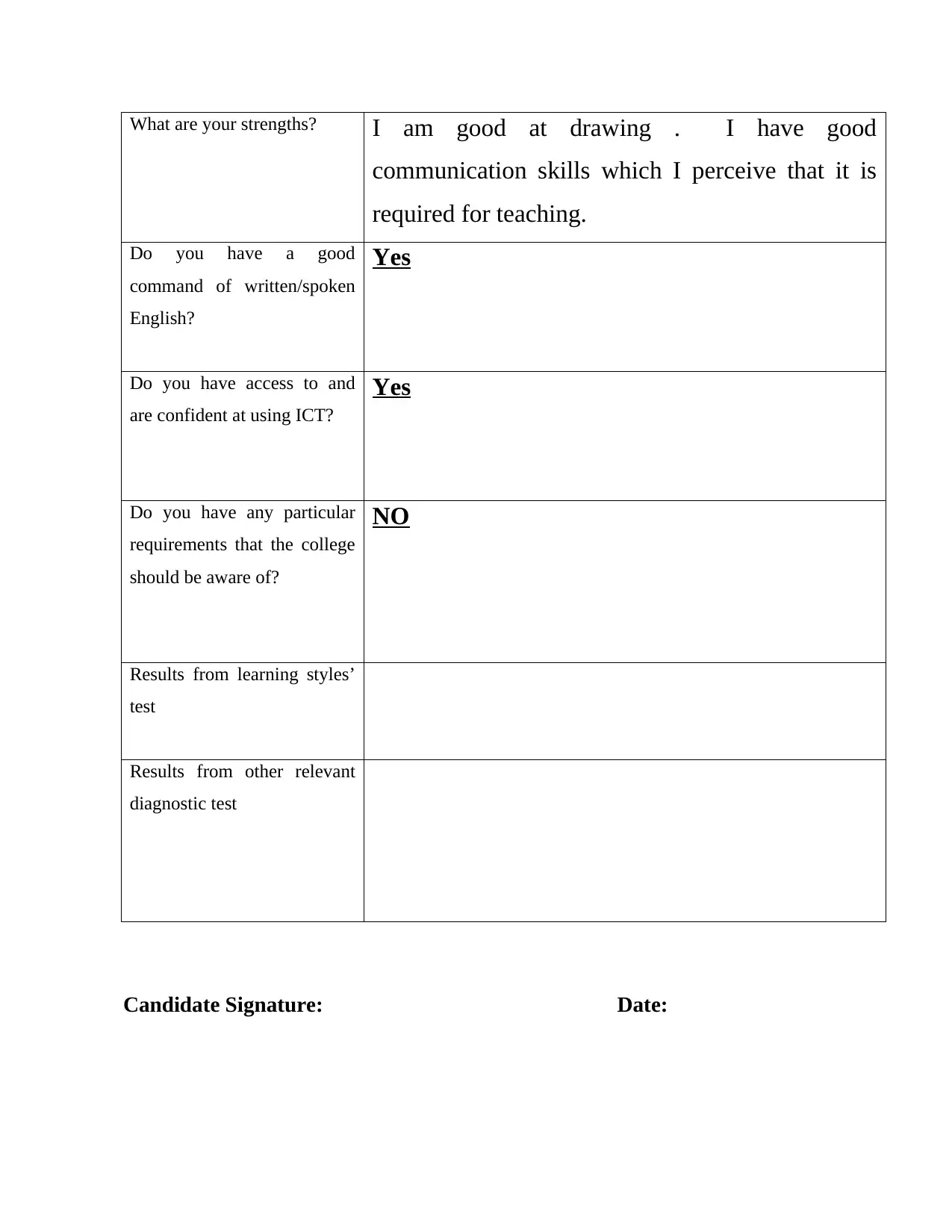
What are your strengths? I am good at drawing . I have good
communication skills which I perceive that it is
required for teaching.
Do you have a good
command of written/spoken
English?
Yes
Do you have access to and
are confident at using ICT?
Yes
Do you have any particular
requirements that the college
should be aware of?
NO
Results from learning styles’
test
Results from other relevant
diagnostic test
Candidate Signature: Date:
communication skills which I perceive that it is
required for teaching.
Do you have a good
command of written/spoken
English?
Yes
Do you have access to and
are confident at using ICT?
Yes
Do you have any particular
requirements that the college
should be aware of?
NO
Results from learning styles’
test
Results from other relevant
diagnostic test
Candidate Signature: Date:
⊘ This is a preview!⊘
Do you want full access?
Subscribe today to unlock all pages.

Trusted by 1+ million students worldwide
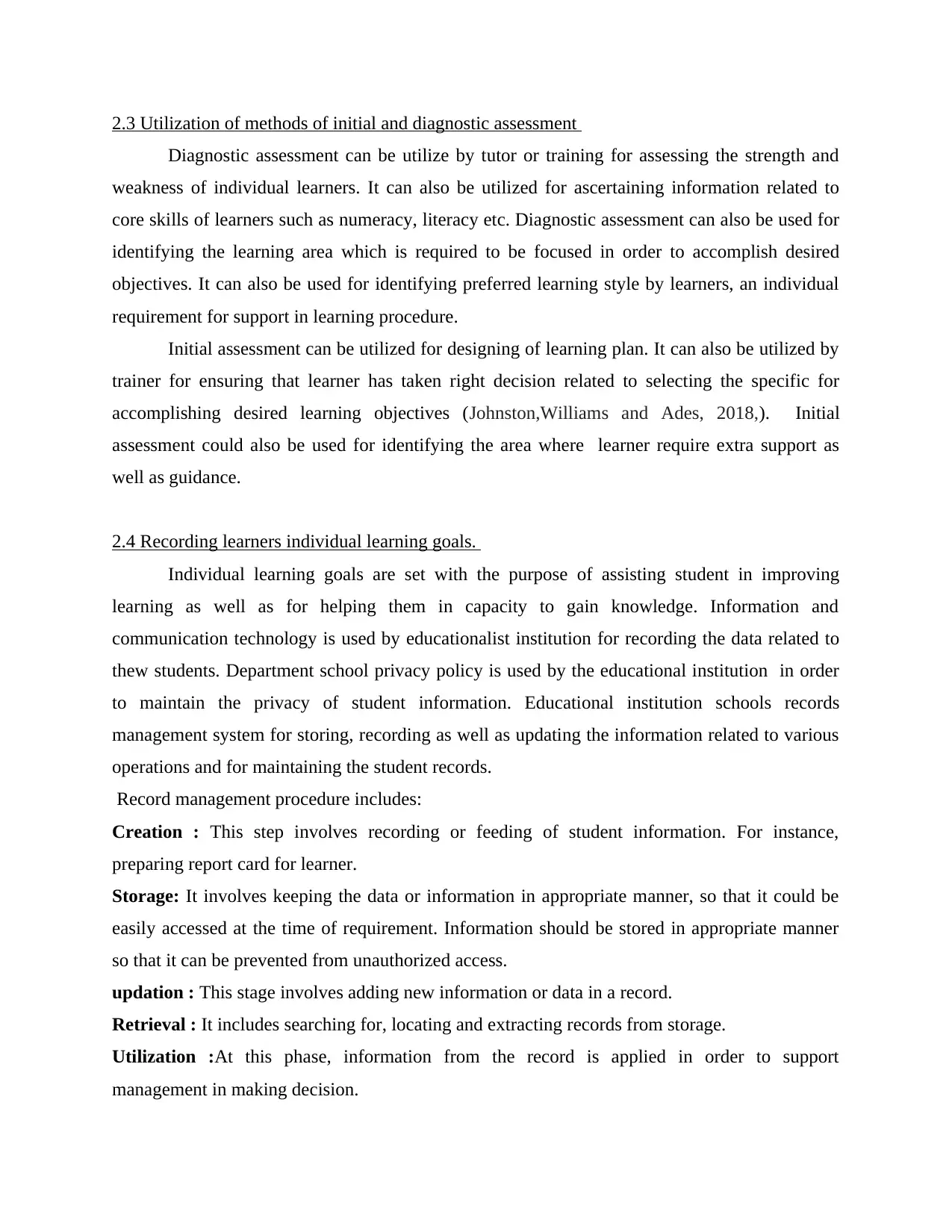
2.3 Utilization of methods of initial and diagnostic assessment
Diagnostic assessment can be utilize by tutor or training for assessing the strength and
weakness of individual learners. It can also be utilized for ascertaining information related to
core skills of learners such as numeracy, literacy etc. Diagnostic assessment can also be used for
identifying the learning area which is required to be focused in order to accomplish desired
objectives. It can also be used for identifying preferred learning style by learners, an individual
requirement for support in learning procedure.
Initial assessment can be utilized for designing of learning plan. It can also be utilized by
trainer for ensuring that learner has taken right decision related to selecting the specific for
accomplishing desired learning objectives (Johnston,Williams and Ades, 2018,). Initial
assessment could also be used for identifying the area where learner require extra support as
well as guidance.
2.4 Recording learners individual learning goals.
Individual learning goals are set with the purpose of assisting student in improving
learning as well as for helping them in capacity to gain knowledge. Information and
communication technology is used by educationalist institution for recording the data related to
thew students. Department school privacy policy is used by the educational institution in order
to maintain the privacy of student information. Educational institution schools records
management system for storing, recording as well as updating the information related to various
operations and for maintaining the student records.
Record management procedure includes:
Creation : This step involves recording or feeding of student information. For instance,
preparing report card for learner.
Storage: It involves keeping the data or information in appropriate manner, so that it could be
easily accessed at the time of requirement. Information should be stored in appropriate manner
so that it can be prevented from unauthorized access.
updation : This stage involves adding new information or data in a record.
Retrieval : It includes searching for, locating and extracting records from storage.
Utilization :At this phase, information from the record is applied in order to support
management in making decision.
Diagnostic assessment can be utilize by tutor or training for assessing the strength and
weakness of individual learners. It can also be utilized for ascertaining information related to
core skills of learners such as numeracy, literacy etc. Diagnostic assessment can also be used for
identifying the learning area which is required to be focused in order to accomplish desired
objectives. It can also be used for identifying preferred learning style by learners, an individual
requirement for support in learning procedure.
Initial assessment can be utilized for designing of learning plan. It can also be utilized by
trainer for ensuring that learner has taken right decision related to selecting the specific for
accomplishing desired learning objectives (Johnston,Williams and Ades, 2018,). Initial
assessment could also be used for identifying the area where learner require extra support as
well as guidance.
2.4 Recording learners individual learning goals.
Individual learning goals are set with the purpose of assisting student in improving
learning as well as for helping them in capacity to gain knowledge. Information and
communication technology is used by educationalist institution for recording the data related to
thew students. Department school privacy policy is used by the educational institution in order
to maintain the privacy of student information. Educational institution schools records
management system for storing, recording as well as updating the information related to various
operations and for maintaining the student records.
Record management procedure includes:
Creation : This step involves recording or feeding of student information. For instance,
preparing report card for learner.
Storage: It involves keeping the data or information in appropriate manner, so that it could be
easily accessed at the time of requirement. Information should be stored in appropriate manner
so that it can be prevented from unauthorized access.
updation : This stage involves adding new information or data in a record.
Retrieval : It includes searching for, locating and extracting records from storage.
Utilization :At this phase, information from the record is applied in order to support
management in making decision.
Paraphrase This Document
Need a fresh take? Get an instant paraphrase of this document with our AI Paraphraser
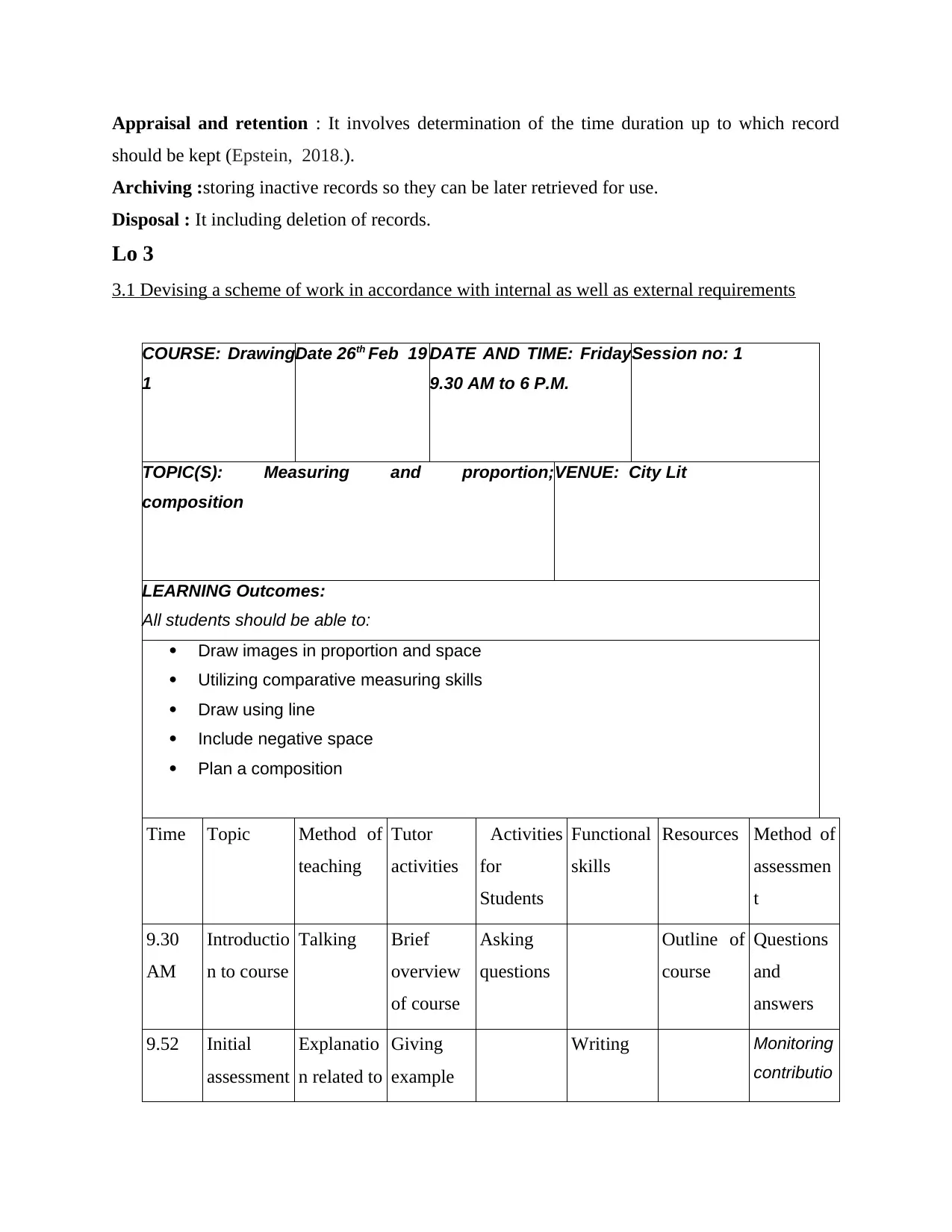
Appraisal and retention : It involves determination of the time duration up to which record
should be kept (Epstein, 2018.).
Archiving :storing inactive records so they can be later retrieved for use.
Disposal : It including deletion of records.
Lo 3
3.1 Devising a scheme of work in accordance with internal as well as external requirements
COURSE: Drawing
1
Date 26th Feb 19 DATE AND TIME: Friday
9.30 AM to 6 P.M.
Session no: 1
TOPIC(S): Measuring and proportion;
composition
VENUE: City Lit
LEARNING Outcomes:
All students should be able to:
Draw images in proportion and space
Utilizing comparative measuring skills
Draw using line
Include negative space
Plan a composition
Time Topic Method of
teaching
Tutor
activities
Activities
for
Students
Functional
skills
Resources Method of
assessmen
t
9.30
AM
Introductio
n to course
Talking Brief
overview
of course
Asking
questions
Outline of
course
Questions
and
answers
9.52 Initial
assessment
Explanatio
n related to
Giving
example
Writing Monitoring
contributio
should be kept (Epstein, 2018.).
Archiving :storing inactive records so they can be later retrieved for use.
Disposal : It including deletion of records.
Lo 3
3.1 Devising a scheme of work in accordance with internal as well as external requirements
COURSE: Drawing
1
Date 26th Feb 19 DATE AND TIME: Friday
9.30 AM to 6 P.M.
Session no: 1
TOPIC(S): Measuring and proportion;
composition
VENUE: City Lit
LEARNING Outcomes:
All students should be able to:
Draw images in proportion and space
Utilizing comparative measuring skills
Draw using line
Include negative space
Plan a composition
Time Topic Method of
teaching
Tutor
activities
Activities
for
Students
Functional
skills
Resources Method of
assessmen
t
9.30
AM
Introductio
n to course
Talking Brief
overview
of course
Asking
questions
Outline of
course
Questions
and
answers
9.52 Initial
assessment
Explanatio
n related to
Giving
example
Writing Monitoring
contributio
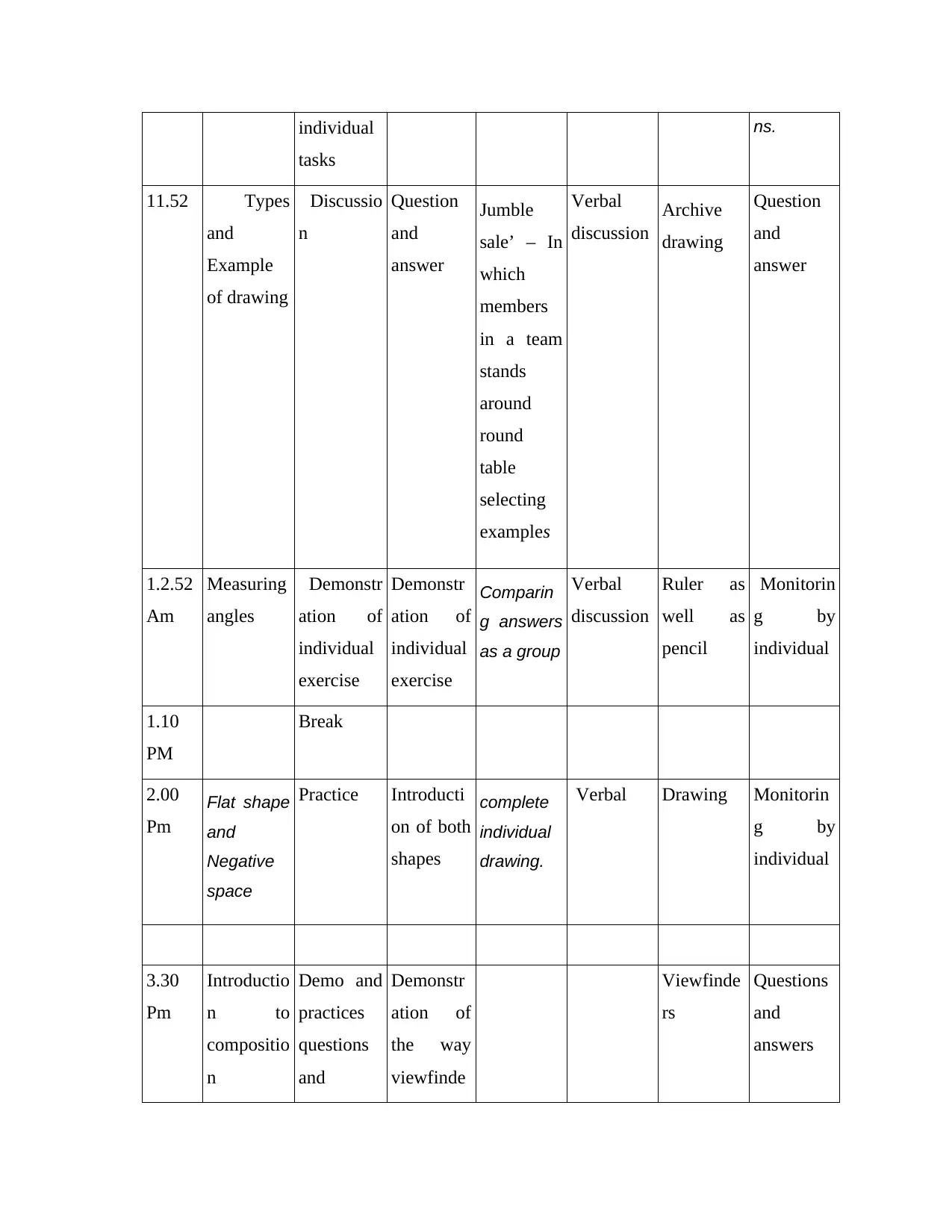
individual
tasks
ns.
11.52 Types
and
Example
of drawing
Discussio
n
Question
and
answer
Jumble
sale’ – In
which
members
in a team
stands
around
round
table
selecting
examples
Verbal
discussion
Archive
drawing
Question
and
answer
1.2.52
Am
Measuring
angles
Demonstr
ation of
individual
exercise
Demonstr
ation of
individual
exercise
Comparin
g answers
as a group
Verbal
discussion
Ruler as
well as
pencil
Monitorin
g by
individual
1.10
PM
Break
2.00
Pm
Flat shape
and
Negative
space
Practice Introducti
on of both
shapes
complete
individual
drawing.
Verbal Drawing Monitorin
g by
individual
3.30
Pm
Introductio
n to
compositio
n
Demo and
practices
questions
and
Demonstr
ation of
the way
viewfinde
Viewfinde
rs
Questions
and
answers
tasks
ns.
11.52 Types
and
Example
of drawing
Discussio
n
Question
and
answer
Jumble
sale’ – In
which
members
in a team
stands
around
round
table
selecting
examples
Verbal
discussion
Archive
drawing
Question
and
answer
1.2.52
Am
Measuring
angles
Demonstr
ation of
individual
exercise
Demonstr
ation of
individual
exercise
Comparin
g answers
as a group
Verbal
discussion
Ruler as
well as
pencil
Monitorin
g by
individual
1.10
PM
Break
2.00
Pm
Flat shape
and
Negative
space
Practice Introducti
on of both
shapes
complete
individual
drawing.
Verbal Drawing Monitorin
g by
individual
3.30
Pm
Introductio
n to
compositio
n
Demo and
practices
questions
and
Demonstr
ation of
the way
viewfinde
Viewfinde
rs
Questions
and
answers
⊘ This is a preview!⊘
Do you want full access?
Subscribe today to unlock all pages.

Trusted by 1+ million students worldwide
1 out of 33
Related Documents
Your All-in-One AI-Powered Toolkit for Academic Success.
+13062052269
info@desklib.com
Available 24*7 on WhatsApp / Email
![[object Object]](/_next/static/media/star-bottom.7253800d.svg)
Unlock your academic potential
Copyright © 2020–2025 A2Z Services. All Rights Reserved. Developed and managed by ZUCOL.



